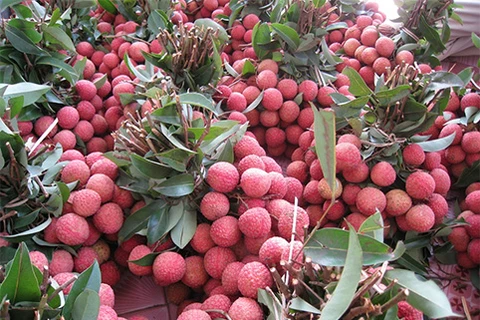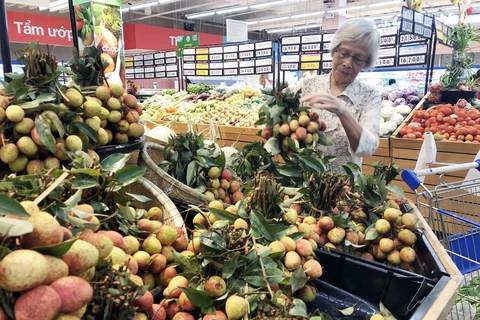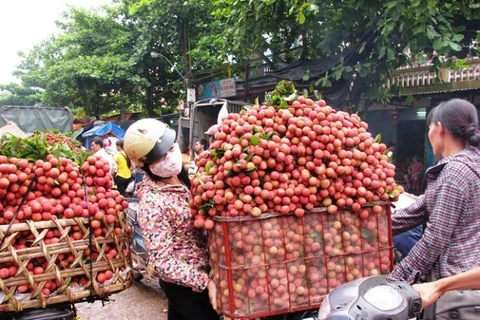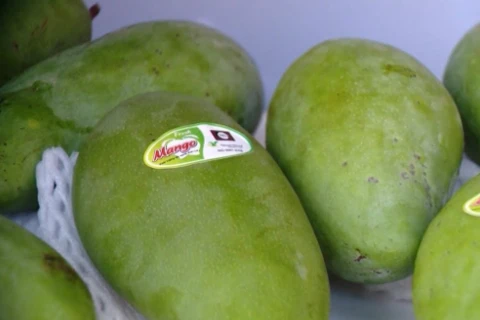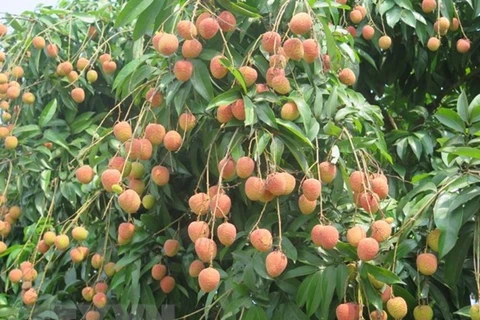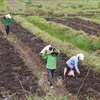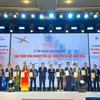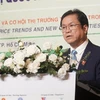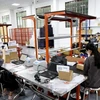Hanoi (VNA) – The Vietnamese lychees licensed to be exported to Japan is a good signal, showing that Vietnam's fruit products are able to conquer the most demanding markets.
 The lychee garden of Le Hong Hai's family in Phuc Gioi village, Thanh Binh commune, Thanh Ha district, Hai Duong province is about to be harvested (Photo: VNA)
The lychee garden of Le Hong Hai's family in Phuc Gioi village, Thanh Binh commune, Thanh Ha district, Hai Duong province is about to be harvested (Photo: VNA) At present, Vietnam's vegetable and fruit industry is facing many difficulties because of strict regulations applied by host countries on quality and epidemic control packaging, and especially preservation technology.
Therefore, the Japanese Ministry of Agriculture, Forestry and Fisheries (MAFF)’s decision to officially open the door for Vietnamese lychees is a good signal for the sector.
Hai Duong, Bac Giang actively seize opportunities
In the face of the above information, in recent days, lychees growers in the northern province of Hai Duong have been very excited.
The provincial agricultural sector wants the Ministry of Agriculture and Rural Development to provide early guidance for localities to proactively seize this opportunity in order to raise the value of lychee and bringing about high incomes to farmers.
Thanh Ha district, known as the lychee capital of Hai Duong, currently has about 4,000 ha of lychee. In the 2019 crop, Thanh Ha's lychee output reached 17,800 tonnes. At present, the district has 90 hectares of lychee in four communes granted with planting area codes eligible for export to such markets as the United States, Australia and Europe.
Thanh Thuy commune of Thanh Ha district has 342ha of lychee; including 85ha of early-ripen lychee. If the weather is favorable, the average yield is about 11 tonnes per ha, generating a profit of 150-160 million VND per ha.
Lychee has been identified as a key fruit tree that brings high economic efficiency to the commune. A local leader said that when hearing the information Japan allowed imports of Vietnamese lychee, the communal People's Committee has instructed the commune’s agricultural service cooperative to remind lychee growing households to follow the caring process according to VietGAP standard.
According to Nguyen Duc Tuan, Secretary of the Thanh Ha district Party Committee, since the beginning of the year, the district has directed the professional agencies to guide farmers to strictly implement the production process to ensure clean lychees up to VietGAP and GlobalGAP standards to meet the requirements of markets, especially export markets.
Meanwhile, in Bac Giang province, Chairman of the provincial People's Committee Duong Van Thai said that immediately after Japan gave permission to Vietnamese fresh lychee imports, Bac Giang has instructed departments, agencies and localities to review requirements and conditions, and guide growers how to follow standard production process so as to meet the requirements of this market.
The province has also prepared plans to cooperate with businesses to proactively approach the market, standing ready for lychee export right from the 2020 crop.
Thai expressed his wish that the agriculture ministry to continue researching and negotiating to expand agricultural product consumption markets; guide localities in the province to organize production up to standards to satisfy the requirements of the Japanese market.
The province wants the ministry to support its connection with businesses that are able to distribute lychees in the Japanese market. Firstly, the ministry should invite AEON supermarket system to sign an agreement with Bac Giang province to export lychees to Japan in 2020.
Vietnamese fruits have conquered demanding markets
By this time, Vietnamese fruits have been present in 60 countries and territories, including very choosy markets. This means that the country’s agricultural production has met the strict traceability regulations.
Dragon fruit is the first fruit of Vietnam to be exported to the US market in 2008. Then, longan, rambutan, lychee, and star apple have also been present in the US market in recent years.
Since 2009, the white-flesh dragon fruit has conquered Japanese consumers - the most demanding market in the world, and then the red-flesh dragon fruit.
Since 2014, some businesses in Vietnam have successfully negotiated and exported lychees to Japan and continued to maintain their shipments until now.
At the end of 2015, the first batch of Cat Chu mangoes was exported to Japan, after five years of preparing documents, developing a new pest treatment process.
On April 17, 2015, after more than 12 years of negotiation, Australia licensed imports of Vietnamese lychees.
Next, in August 2016, Australia granted permission to Vietnamese mango imports and on August 24, 2017, it allowed imports of dragon fruit from Vietnam after seven years of negotiation.
In late 2018, Vietnam's first batch of rambutan was shipped to New Zealand, a choosy market with very high requirements and quarantine standards. Previously, no country had been allowed to export rambutan to this country.
In mid-February 2019, after more than 10 years of negotiation, mango is the 6th fruit of Vietnam officially licensed to be exported to this strict market, making the US the 40th export market of Vietnamese mango.
In August 2019, after satisfying strict quality control standards from partners, Vietnam’s fresh longan was officially approved by Australia's Department of Agriculture and Water Resources to be exported to this country./.

